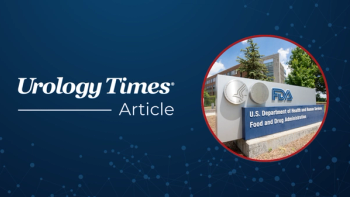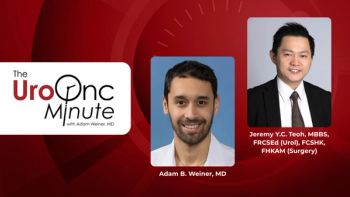
EV plus pembrolizumab doubles CR rate vs chemotherapy in la/mUC
Key Takeaways
- EV+P showed a higher complete response rate and longer duration of response than chemotherapy in urothelial carcinoma patients.
- The median overall survival and progression-free survival were significantly improved with EV+P compared to chemotherapy.
According to the authors, these data reinforce EV plus pembrolizumab as the first-line standard of care for la/mUC.
The proportion of patients achieving a complete response (CR) with enfortumab vedotin (EV) plus pembrolizumab (P; Keytruda) was double that of those who received platinum-based chemotherapy, and CRs with EV+P tended to be of better quality, according to an exploratory analysis of the EV-302 trial (KEYNOTE-A39; NCT04223856).1
The data were presented by Shilpa Gupta, MD, of Cleveland Clinic at the
In total, the phase 3 EV-302 trial enrolled 886 patients with locally advanced/metastatic urothelial carcinoma (la/mUC) who were randomly assigned 1:1 to receive EV+P (n = 442) or platinum-based chemotherapy (n = 444).
At a median follow-up of 29.1 months, data showed an objective response rate (ORR) of 67.5% in the EV+P arm, which consisted of a CR rate of 30.4% and a partial response (PR) rate of 37.1%. In the chemotherapy arm, the ORR was 44.2%, which consisted of a CR rate of 14.5% and a PR rate of 29.7%. Among those who achieved a CR, 66.2% of those in the EV+P arm and 59.4% of those in the chemotherapy arm achieved an initial PR and were later converted to CR.
Gupta noted during the presentation, “The baseline characteristics amongst responders in the EV/pembro arm was consistent with the [intent to treat] population across age, ECOG performance status, primary tumor location, sites of metastases, as well as cisplatin eligibility status.”
At 2 years, the probability of a maintained response was around 50% in the EV+P arm. The median duration of response (DOR) in the EV+P arm was 23.3 months (95% CI, 17.8 to NE) vs 7.0 months (95% CI, 6.2 to 9.0) in the chemotherapy arm.
The DOR benefit in the EV+P arm was observed in both cisplatin eligible and cisplatin ineligible patients. Overall, 58.3% of responders in the EV+P arm vs 62.6% of responders in the chemotherapy arm were cisplatin eligible.
Among cisplatin ineligible patients, the median DOR was 21.9 months (95% CI, 15.7 to NE) in the EV+P arm vs 6.6 months (95% CI, 5.5 to 9.3) in the chemotherapy arm. This trend was consistent in cisplatin eligible patients, with a median DOR of 24.4 months (95% CI, 17.8 to NE) in the EV+P arm vs 8.3 months (95% CI, 5.9 to 10.8) in the chemotherapy arm.
Among patients who received EV+P, the probability of maintaining a complete response at 2 years was 74.3%. The median duration of CR was not reached in the EV+P arm vs 15.2 months (95% CI, 10.3 to NE) in the chemotherapy arm.
On this finding, Gupta added, “That shows that not just the number of responses was higher, but the quality and durability was better.”
This trend was also observed amongst those patients who achieved a PR. The median duration of response was 10.6 months (95% CI, 8.4 to 14.6) in the EV+P arm vs 5.4 months (95% CI, 4.5 to 6.1) in the chemotherapy arm.
Overall, 95.4% of complete responders in the EV+P arm were alive at 2 years. The median overall survival (OS) was not reached in either arm at the time of data report (stratified HR, 0.37; 95% CI, 0.17 to 0.80).
The median number of cycles of enfortumab vedotin was 9 in the overall population (n = 440), which increased to 12 among those who achieved a CR or PR (n = 295) and 13 among those who achieved a CR (n = 133). This trend was also observed in regard to the median number of pembrolizumab cycles, which was 11 in the overall population, and increased to 17 among those who achieved a CR or PR and 27 in those who achieved a CR.
Longer treatment duration in responders did not appear to cause a significant worsening of safety in the EV+P cohort. In the overall population, the median duration of EV treatment was 7.1 months. Among responders, the median duration of EV treatment was 9.7 months.
In the overall study population, grade 3 or higher adverse events (AEs) occurred in 57.3% of patients in the EV+P arm vs 69.5% of patients in the chemotherapy arm. Among the responders (CR or PR), grade 3 or higher AEs occurred in 61.4% of patients in the EV+P arm vs 66.2% of patients in the chemotherapy arm.
Looking at treatment-related adverse events (TRAEs) of special interest with EV, the most common toxicities were peripheral sensory and motor neuropathy, rash, severe cutaneous reactions, hyperglycemia, and ocular toxicities. The treatment-emergent AEs of special interest for pembrolizumab were consistent with previously reported data.
TRAEs led to dose interruptions for EV in 59.8% of patients in the overall population and 69.2% of responders (CR+PR). Further, dose interruptions for pembrolizumab due to TRAEs were noted in 50.7% of patients in the overall population vs 62.4% of responders (CR+PR). TRAEs leading to a dose reduction in EV was reported in 43% in the overall population and 53.9% in the responders (CR+PR).
Overall, Gupta concluded, “Collectively, these data reinforce EV/pembro as the standard of care for first-line treatment of patients with locally advanced/metastatic urothelial cancer, irrespective of baseline characteristics, including cisplatin eligibility.”
About EV-302
In total, the phase 3 EV-302 trial enrolled 886 patients with la/mUC who had not been previously treated with systemic therapy. Patients were randomly assigned 1:1 to receive EV+P (n = 442) or platinum-based chemotherapy (n = 444). Data from the trial were previously published in the New England Journal of Medicine, showing that the combination of EV+P significantly improved OS and progression-free survival (PFS) vs chemotherapy.2
Updated data from the trial, concurrently published in Annals of Oncology alongside the EV-302 presentation at ASCO, provided updated data with 2.5 years of follow-up.3
Overall, at a median follow-up of 29.1 months, the median OS was 33.8 months (95% CI, 26.1 to 39.3) in the EV+P arm vs 15.9 months (95% CI, 13.6 to 18.3) in the chemotherapy arm (HR, 0.51; 95% CI, 0.43 to 0.61; P < .00001). Additionally, the median PFS was 12.5 months (95% CI, 10.4 to 16.6) in the EV+P arm vs 6.3 months (95% CI, 6.2 to 6.5) in the chemotherapy arm (HR, 0.48; 95% CI, 0.41 to 0.57; P < .00001).
Initial data from this trial led to the FDA approval of EV+P for la/mUC in December 2023.
REFERENCES
1. Gupta S, Bedke J, Van Der Heijden M, et al. Exploratory analysis of responders from the phase 3 EV-302 trial of enfortumab vedotin plus pembrolizumab (EV+P) vs chemotherapy (chemo) in previously untreated locally advanced or metastatic urothelial carcinoma (la/mUC). J Clin Oncol. 2025;43 (suppl 17; abstr 4502). doi:10.1200/JCO.2025.43.16_suppl.4502
2. 3. Powles T, Valderrama BP, Gupta S, et al. Enfortumab vedotin and pembrolizumab in untreated advanced urothelial cancer. N Engl J Med. 2024;390(10):875-888. doi:10.1056/NEJMoa2312117
3. Enfortumab vedotin plus pembrolizumab in untreated locally advanced or metastatic urothelial carcinoma: 2.5-year median follow-up of the phase III EV-302/KEYNOTE-A39 trial. Annals of Oncol. 2025. doi:10.1016/j.annonc.2025.05.536
Newsletter
Stay current with the latest urology news and practice-changing insights — sign up now for the essential updates every urologist needs.



















